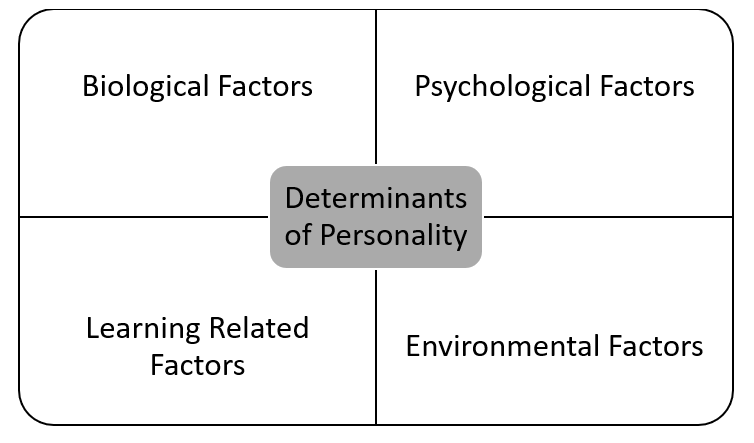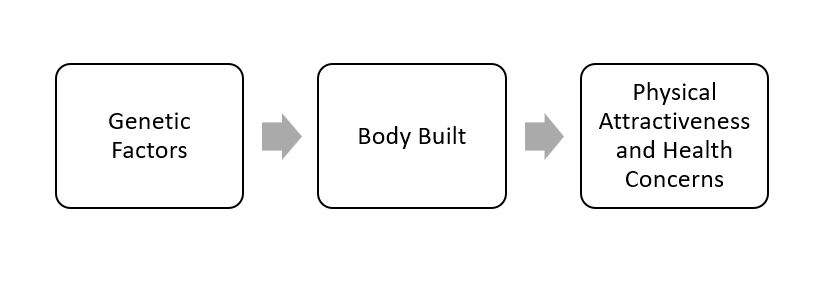Introduction
Personality is a broad and multi-faceted concept in psychology, often characterized by individuality, consistency, and dynamism. It refers to the relatively stable and unique ways in which an individual thinks, feels, and behaves, shaping their interactions with the environment. Allport (1937, 1961) defined personality as the dynamic organization within the individual of those psychophysical systems that determine his characteristic behavior and thought.
Personality development is influenced by several factors, often categorized into biological, psychological, and environmental determinants. These factors interact in complex ways to shape personality traits, dispositions, and behaviors, contributing to an individual’s overall psychological makeup.

Determinants of Personality
1. Biological Determinants of Personality
Biological factors play a crucial role in personality development. These include genetic influences, body build, physical attractiveness, and health conditions, among others.
- Genetic Influences
The genetic basis of personality is supported by a large body of research. Twin studies, for instance, have been instrumental in highlighting the role of heredity in personality. Monozygotic (identical) twins, who share 100% of their genes, tend to exhibit more similar personality traits compared to dizygotic (fraternal) twins, who share about 50% of their genes. Studies by Bouchard et al. (1990) demonstrated that genetic factors account for a significant portion of variance in personality traits, with estimates ranging from 40% to 60%.
In a seminal study, Tellegen et al. (1988) examined the heritability of the Big Five personality traits (openness, conscientiousness, extraversion, agreeableness, and neuroticism). They found substantial genetic contributions to these traits, supporting the notion that personality is, to some extent, hardwired.
- Body Build
Early theories on body build and personality, such as those proposed by Sheldon (1942), suggested a correlation between physical constitution and personality types. Sheldon classified individuals into three somatotypes:
- Ectomorphs (slim, lean) are associated with introversion, sensitivity, and thoughtfulness.
- Mesomorphs (muscular, athletic) tend to exhibit traits of assertiveness, boldness, and competitiveness.
- Endomorphs (round, soft) are linked with sociability, relaxation, and emotional warmth.
Although Sheldon’s work has been criticized for lack of empirical rigor, subsequent research has found some evidence linking body image and personality traits, particularly in relation to self-esteem and social perceptions.
- Physical Attractiveness and Health Conditions
Physical attractiveness and health conditions are also influential in shaping personality. Attractive individuals often receive more positive social reinforcement, which can impact their self-esteem, confidence, and social skills. Health conditions, both chronic and acute, can affect personality traits by influencing an individual’s outlook on life, coping mechanisms, and emotional stability.
A study by Langlois et al. (2000) demonstrated that physical attractiveness is associated with positive social interactions and outcomes, which in turn can shape personality development, particularly in terms of extraversion and sociability.

Biological Factors
2. Psychological Determinants of Personality
Psychological factors are intrinsic to the individual and include intellectual abilities, emotional responses, and various self-concepts. These factors play a significant role in shaping personality across the lifespan.
- Intellectual Factors
Intellectual abilities, such as problem-solving, reasoning, and creativity, contribute to personality development. Individuals with higher cognitive abilities may develop traits like openness to experience, curiosity, and adaptability. Conversely, intellectual challenges or limitations can influence emotional stability, confidence, and social behavior.
Chamorro-Premuzic and Furnham (2006) conducted studies that highlighted the relationship between intelligence and personality traits, showing that higher cognitive abilities were positively correlated with openness to experience and conscientiousness.
- Emotional Factors
Emotional factors, including emotional regulation, self-awareness, and affective responses, are central to personality development. Early emotional experiences, especially during childhood, shape an individual’s emotional intelligence, resilience, and interpersonal relationships.
Excessive love or affection from caregivers can foster secure attachment styles, leading to personality traits like warmth, trust, and openness. In contrast, emotional neglect or abuse may result in insecure attachment, influencing traits like neuroticism, anxiety, and distrust.
Bowlby’s (1969) attachment theory emphasizes how early emotional bonds with caregivers impact personality development. Securely attached individuals tend to exhibit healthier personality traits, such as emotional stability and social competence.
- Self-Disclosure and Achievement
Personality traits are also shaped by how individuals disclose personal information and pursue their goals. Self-disclosure involves sharing personal thoughts and feelings, which can impact interpersonal relationships and social adjustment. High levels of self-disclosure are often linked to traits like openness and emotional stability.
Similarly, aspiration and goal-setting behavior contribute to personality development. Individuals with high achievement motivation tend to display traits of conscientiousness, diligence, and perseverance, while those with low motivation may exhibit traits like passivity and neuroticism.
McClelland’s (1961) theory of achievement motivation posits that individuals with a strong need for achievement are more likely to pursue challenging tasks and persist in the face of difficulties, shaping their personality over time.

Psychological Factors
3. Environmental Determinants of Personality
Environmental factors refer to the external influences that shape an individual’s personality. These include social acceptance, family dynamics, educational experiences, and cultural context.
- Social Acceptance and Social Deprivation
Social acceptance, or the degree to which an individual is welcomed and valued by others, can significantly influence personality. Individuals who experience social acceptance are more likely to develop positive self-esteem, confidence, and social skills. On the other hand, social deprivation, such as isolation or rejection, can lead to feelings of inadequacy, anxiety, and withdrawal.
Research by Baumeister and Leary (1995) highlights the importance of social belonging in human behavior. Individuals who feel socially accepted tend to exhibit traits like extraversion and agreeableness, while those who experience rejection are more likely to develop neuroticism and social anxiety.
- Family Emotional Climate
The family emotional climate, which includes parenting styles, sibling relationships, and overall family dynamics, is a powerful determinant of personality. Warm and supportive family environments foster secure attachment and emotional stability, leading to positive personality traits. In contrast, chaotic or conflict-ridden family environments can contribute to the development of maladaptive traits like aggression, hostility, and emotional instability.
Baumrind (1967) identified different parenting styles (authoritative, authoritarian, and permissive) and their impact on personality development. Children raised in authoritative families, where parents are both nurturing and firm, tend to develop traits like self-confidence, sociability, and emotional resilience.
- Educational Factors
Education plays a critical role in shaping personality by influencing cognitive development, self-concept, and social interactions. Schools provide an environment where individuals learn social norms, develop self-discipline, and pursue intellectual growth. Educational experiences can promote traits like conscientiousness, adaptability, and emotional intelligence.
A study by Hogan and Roberts (2004) found that education significantly correlates with personality traits, particularly in terms of increasing openness to experience and conscientiousness. They also noted that educational attainment promotes emotional regulation and intellectual engagement.
- Cultural and Societal Influences
Cultural and societal contexts shape personality development by defining norms, values, and expectations. Individualistic cultures, which emphasize autonomy and personal achievement, tend to foster traits like independence, assertiveness, and self-reliance. In contrast, collectivist cultures, which prioritize group harmony and interdependence, encourage traits like cooperation, empathy, and social responsibility.
Research by Triandis (1995) on cultural dimensions showed that cultural values have a significant impact on personality traits. For example, individuals from collectivist cultures are more likely to exhibit agreeableness and conformity, while those from individualistic cultures tend to display extraversion and assertiveness.

Enviornmental Factors
4. Learning Processes and Personality Development
Personality development is not static but evolves over time through various learning processes, including imitation, reinforcement, and social learning.
- Imitation
Imitation, or observational learning, plays a significant role in shaping personality. Individuals often model their behavior on influential figures in their lives, such as parents, teachers, or peers. Through imitation, individuals learn social norms, emotional responses, and coping strategies.
Bandura’s (1977) social learning theory emphasizes the role of observational learning in personality development. He demonstrated that individuals, especially children, acquire behaviors by observing others and imitating their actions.
- Reinforcement and Punishment
The principles of reinforcement and punishment, as outlined in Skinner’s (1953) operant conditioning theory, also contribute to personality development. Behaviors that are reinforced are more likely to be repeated, while those that are punished tend to diminish. Positive reinforcement encourages traits like sociability and responsibility, while negative reinforcement or punishment can lead to traits like anxiety or aggression.
Skinner’s work on operant conditioning provided empirical support for the role of reinforcement in shaping behavior and personality traits. Positive reinforcement of desirable behaviors fosters traits like conscientiousness and sociability, while punishment can contribute to the development of traits like fearfulness or defiance.

Learning Related Factors
Conclusion
In conclusion, personality is a complex and dynamic construct influenced by an interplay of biological, psychological, and environmental factors. Genetic predispositions, intellectual abilities, emotional experiences, family dynamics, and cultural contexts all contribute to the development of personality. Through learning processes like imitation and reinforcement, individuals continuously refine and modify their personality traits
Over time. Understanding these determinants allows psychologists to better comprehend the nuances of personality development and offers insight into how personality shapes behavior across the lifespan.
References
Allport, G. W. (1937, 1961). Pattern and Growth in Personality. Holt, Rinehart & Winston.
Bandura, A. (1977). Social Learning Theory. Prentice-Hall.
Baumrind, D. (1967). Child Care Practices Anteceding Three Patterns of Preschool Behavior. Genetic Psychology Monographs, 75(1), 43-88.
Baumeister, R. F., & Leary, M. R. (1995). The need to belong: Desire for interpersonal attachments as a fundamental human motivation. Psychological Bulletin, 117(3), 497-529.
Bouchard, T. J., et al. (1990). Sources of human psychological differences: The Minnesota study of twins reared apart. Science, 250(4978), 223-228.
Chamorro-Premuzic, T., & Furnham, A. (2006). Intellectual competence and personality traits: Empirical evidence. Educational Psychology, 26(6), 803-823.
Hogan, R., & Roberts, B. W. (2004). A socioanalytic model of maturity: The role of personality traits and intelligence in the prediction of career success. Journal of Applied Psychology, 89(4), 762-773.
Langlois, J. H., et al. (2000). Maxims or myths of beauty? A meta-analytic and theoretical review. Psychological Bulletin, 126(3), 390-423.
McClelland, D. C. (1961). The Achieving Society. Princeton, NJ: Van Nostrand.
Sheldon, W. H. (1942). The Varieties of Temperament. Harper & Row.
Skinner, B. F. (1953). Science and Human Behavior. Macmillan.
Tellegen, A., et al. (1988). Personality similarity in twins reared apart and together. Journal of Personality and Social Psychology, 54(6), 1031-1039.
Triandis, H. C. (1995). Individualism and Collectivism. Westview Press.
Subscribe to Careershodh
Get the latest updates and insights.
Join 15,198 other subscribers!
Niwlikar, B. A. (2024, October 15). Determinants of Personality- Discover 4 Factors that Make Personality. Careershodh. https://www.careershodh.com/determinants-of-personality/
